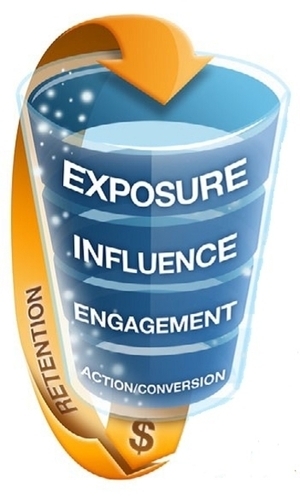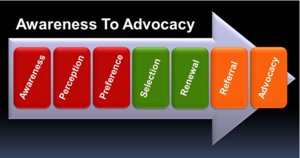Where's The Social Sales Professional?
Have you heard what they’re saying?
 Analysts watching emerging engagement trends have identified sales professionals as the least likely group to commit to the adoption and use of social media. Really? Marketing departments and communication teams get it. Public relations and brand managers are on board. And now we’re seeing a shift toward the use of social media by customer service teams and contact centers as well. What about social media for sales people? Why has it taken that group longer to catch on and catch up to their peers throughout the organizations that they work for?
Analysts watching emerging engagement trends have identified sales professionals as the least likely group to commit to the adoption and use of social media. Really? Marketing departments and communication teams get it. Public relations and brand managers are on board. And now we’re seeing a shift toward the use of social media by customer service teams and contact centers as well. What about social media for sales people? Why has it taken that group longer to catch on and catch up to their peers throughout the organizations that they work for?
Some argue that the lack of explicit buy-in is due in large part to the time-honored truism often expressed as WIIFM, or “what’s in it for me?” In short, the sales professional hasn’t been able to see the sale as an outcome of their engagement. Are you still wondering how time spent utilizing popular social media tools will favorably impact your revenue and income? Let’s look for some answers.
In order for us to discover the benefits of social engagement in online communities, we first have to create a clear line of sight to results. We need more obvious connections between the use of social media and the outcome of improved revenue and financial value for the company, agency, and sales rep. Let’s consider how social media translates to a model we are all familiar with – we know it as “the sales funnel.” It should be noted, that while I’ve chosen to demonstrate social marketing through the sales funnel model our conversation could just as aptly apply to the Awareness to Advocacy model. I look forward to expanding on those thoughts at another time.
There are five primary categories of social media metrics that can be identified within the sales funnel. While various thought leaders and analysts may have their own names for these connections, I’ve found the concepts that are presented to be quite similar in their intent.
Exposure is a measurement of brand reach that sits at the top of the sales funnel. Putting more people into the top of a carrier, agency, or individual sales funnel, by effectively utilizing social media tools, will result in increased conversion at the bottom.
Influence by friends and neighbors is at an all-time high when it comes to drivers of purchase decisions. In 2010, just as many PEMCO customers said that their insurance purchase was influenced by the recommendation of a friend or family member as those who said price was the primary factor. Most social media tools and online communities have a “baked in” ability for influence and sharing. To be “Liked” on Facebook or to be “Retweeted” on Twitter can be compared to a recommendation by a friend – they tend to have loyal fans that trust their credibility and therefore convert at a higher rate.
Engagement requires consumers to involve themselves with your brand. In social media terms, that means that your corporate and personal brands have to be available and compelling. Are you present in the popular forums, platforms, and communities? Is your content interesting and relevant? Are friends and fans of your brand sharing, retweeting, commenting, linking to and liking what you’ve provided? To move people through the funnel to conversion, the answer to these questions needs to be yes. And it needs to be easy!
Conversion is where the action is at for sales professionals. Unfortunately, the sales funnel doesn’t have conversion as a front door. Now, more than ever, it’s essential that sales professionals spend time and attention on exposure, influence, and engagement. When the time is right, and when a lead-triggering event occurs, the socially engaged sales professional will see the benefits from the connections that have been invested in with increases in potential customers and influencers.
Retention is the key to long-term success within any sales organization. Retained customers strengthen a company’s financial reserves and have a positive impact on the ability to establish and maintain competitive prices in the future. Retained customers are evidence of a company that “gets it” and is meeting and exceeding consumer needs. Retained customers fuel the next round of referrals and recommendations. Without retained customers there would be no advocates. Staying engaged with your growing community of retained customers is an investment in your near- and long-term success
It is increasingly obvious that being socially engaged sales professionals will soon become an essential component of success. As with most new skills, it will require effort and understanding. It’ll be necessary to practice with the tools, messages, and methods of engagement. Those who are most successful are often the same people who have made an effort to gain comfort with tools like Facebook, Twitter, and LinkedIn at a personal level before beginning a major outreach on a professional basis. While it may be true the early bird gets the worm, it is also true that most birds learn to use their wings before they can successfully feed themselves.
Remember, social media is like the almighty assist. It can help add more opportunities to convert business, but at the end of the day it is simply a tool you can use to build and influence relationships and connections. How you listen, how you’re affected, and how you connect and respond will determine the quality of the relationships that you create and the leads you generate into the sales funnel.
Will you be a social sales professional?
Note: For purposes of illustration, the social funnel graphic was borrowed from FullFrontalROI.com.


Add A New Comment
Mar. 29, 2012 03.29.2012 17:28 (Reposted from "All Things WOM)
Hi Rod,
Great post and illustrations. Based on your explanation here, I gather that Brand exposure is very important from this perspective. Perception and influence will be greatly affected by the attributes of the brand. If you place a tremendous amount of focus on your brand exposure, its likely that you will have greater influence on the general population and therefore increasing the engagement and conversion. What I find to be most interesting is that many of these concepts have existed for years, but with the rise of social media and other digital marketing, they have become so greatly articulated. Social media definitely has become a tool that allows perception to proliferate across digital mediums throughout online communities and I believe that adopting social media will be inevitable for successful businesses. The perception of a brand can no longer be broadcast and determined by a company or organization. The perception and influence is now in the hands of consumers and online groups. In the today’s social media influenced world, online communities can tarnish a brand or put it on a pedestal overnight.
Jack
Mar. 27, 2012 Great point, logically explained, succinctly put.
I've spoken with a good number of sales people who are too busy making money to dive into social media, and even if they did (or so they believe) not enough of their customers and/or prospects are accessible via social media to make it a rich hunting ground for them. For these folks nothing less than a case study that perfectly matched their circumstances—a guarantee of success, in other words—would justify the diversion from what they are already doing.
The big exception to the above is in the recruiting field, if you grant the similarity between "sales" and "recruiting". Recruiters are getting incredible traction with tools liked LinkedIn and would be terrifically handicapped without it. So it would be interesting to see a series of case studies about using LinkedIn for B2B sales, for example.
thanks,
- Bruce
Mar. 25, 2012 This is excellent thinking. As a career software sales pro, I entirely agree with your assessment. Even those of us that actually sell social media software don't adopt these principals as they should. I think sales people are so incredibly threatened by cultural change that they don't take the time to understand and recognize social sales. Sales people don't like to think that someone other than them is influencing the sale. Sales people like to control the process from inception. Social media has the potential to dramatically increase the sales cycle, as the sales person must listen more than she talks and be more consultative and patient.
Things started changing when companies started making vast amounts of information available to the consumer/corporate buyer the internet. Social media added jet fuel and crack to the flow of information.
I'm not looking for relief on the sales side until the senior executives pivot their thinking and realize that the times, they are a-changin'.
Steve